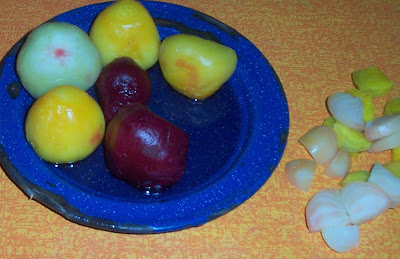WEDNESDAY, JULY 28, 2010
A Busy Day in the Kitchen
We've had a busy week in the kitchen putting things into canning jars. Hot, tiring work to be sure, but I know the reward will be worth it. Katie canned a canner load of Rattlesnake pole beans this morning, our first of the year. I was working on Rebekah's birthday presents while she did that and then we canned blueberries and pickled heirloom beets this afternoon/evening. Our beet varieties are: Chioggia, Golden, Lutz Winter Keeper. I don't think I'm a huge pickled beet fan, but they will add variety to the dullness of Winter's protein-heavy repast. I think we're about finished with the blueberries, I ought to make more syrup since what I did make is making its way to New York before long and I have none left for us. We'll see, I know we'll be elbow deep in peaches tomorrow and/or Friday and I don't want to bite off too much. This is our Pickled Beet recipe, it's from 1911.
-------------------------------------------------------------------------
Pickled Heirloom Beets
1. Wash beets and trim off beet greens. Dispatch a child to feed the greens to the pigs; meanwhile leave roots and 1 inch of stems and cook until tender, about a half hour more or less.
Drain beets, cool and peel. Next, admire them on the plate.

2. Cut into slices or cubes, place in jars and pack them in but don'tcrush them. Then admire them some more and call all of the children in to remark on the pleasing aesthetics that beets entail.

3. In a separate kettle combine: 4 cups cider vinegar, 2 cups brown sugar, 2 cups water, 1.5 teaspoons canning salt, and in a spice bag put 2 cinnamon sticks, 12 whole cloves and 1 teaspoon whole allspice. Add spice bag to vinegar/sugar and boil for 5 minutes or the amount of time that it takes a 4 year old to tell you about the presents that she wants for her birthday which is still 4 months away. Remove spice bag and ladle syrup over beets in jars.

4. Put bands and lids in place and can in a boiling water bath canner for a half hour. Watch the storm roll in as you frantically grab the laundry from the clothesline with clothes pins flying every which way. Let it occur to you at 5:30 that you have nothing prepared for Supper and call for pizza.
Be thankful for everything that was accomplished in a day's time and doubly thankful that every day isn't like today. :-D










































